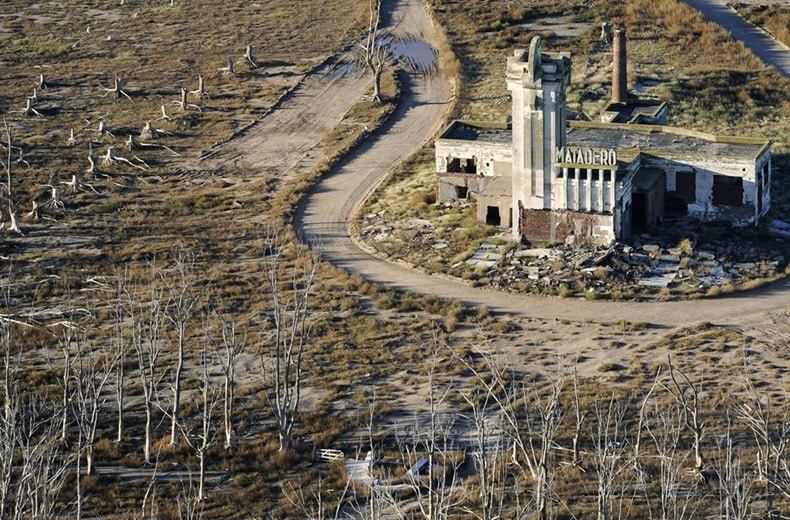Villa Epecuen: A Town That Was Submerged For 25 Years
A tourist town called, Villa Epecuen was established back in the 1920s along the shore of Lago Epecuen. This salt lake is about 600 kilometers southwest of Buenos Aires, Argentina. Lago Epecuen is like other mountain lakes except for one main factor – it;s salt levels second only to the Dead Sea making it ten times higher than any ocean.
This resort town thrived for several decades and even had a railroad station. It’s population in the 1970’s peaked to 5,000, it was around that time a long-term weather event delivered an unusually heavy rainstorm to the region which surrounded the hills for years, making Lago Epecuen swell.
In 1985 the salty waters broke through the earthen dam, submerging the town of Villa Epucuen. A slow growing flood consumed the town and reached it’s peak of 10 meters (33 feets) in 1993. The waters began to recede in 2009, AFT photographer Juan Mabromata recently visited the town of Villa Epucuen that submerged 25 years ago.

By late nineteenth century, the first residents and visitors started to arrive to Villa Epecuen and set up tents on the banks. Villa Epecuen transformed from a sleepy mountain village to a bustling tourist resort. The village soon had a railway line linking it to Buenos Aires. Before long, tourists from all over South American and the World came flocking, and by the 1960s, as many as 25,000 people came every year to soak in the soothing salt water. The town’s population peaked in the 1970s with more than 5,000. Nearly 300 businesses thrived, including hotels, hostels, spas, shops, and museums.
Around the same time, a long-term weather event was delivering far more rain than usual to the surrounding hills for years, and Lago Epecuen began to swell. On 10 November 1985 the enormous volume of water broke through the rock and earth dam and inundated much of the town under four feet of water. By 1993, the slow-growing flood consumed the town until it was covered in 10 meters of water.
Nearly 25 years later, in 2009, the wet weather reversed and the waters began to recede. Villa Epecuen started coming back to the surface.
No one returned back to the town, except 81-year-old Pablo Novak who is now Villa Epecuen’s sole resident.
“I am OK here. I am just alone. I read the newspaper. And I always think of the towns golden days back in the 1960s and 70s,†Novak says.
In 2011, AFP photographer Juan Mabromata visited the ruins of Villa Epecuen, met its sole inhabitant, and returned with these images.






The former slaughterhouse of Villa Epecuen, Argentina, among a stand of long-dead trees, photographed on May 4, 2011.


Norma Berg gestures next to the ruins of her family house in Villa Epecuen, Argentina, on May 3, 2011.




A thin layer of salt, cracked, revealing the original paint of the wall of a collapsed building in Villa Epecuen, Argentina, on May 3, 2011.


Lone inhabitant of Villa Epecuen, 81-year-old Pablo Novak tends his wood stove at his on May 3, 2011.





The road leading to the cemetery of Carhue, near Villa Epecuen, at sunset on May 4, 2011.

A man compares a photograph of Villa Epecuen taken in the 1970’s with the current state of the place, after almost 25 years beneath the water of Lago Epecuen.
Sources: The Atlantic, Wikipedia, Lostresorts




